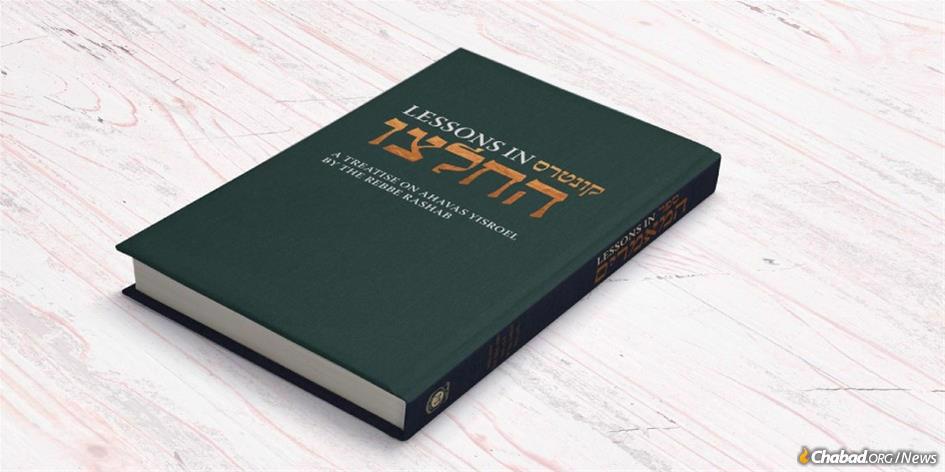One of the trademark features of any Chassid is an abundant love of one’s fellow. This endless feeling of concern for the material and spiritual well-being of others has inspired so many Chabad rabbis and their wives to move to far-flung corners of the earth and set up lifetime posts of service.
What is the secret of this boundless love?
A new book published by Sichos In English titled Lessons in Heichaltzu provides a window into the secret sauce that makes Chassidic love unique. A translation interwoven with extensive explanation, this new volume presents a storied Chassidic discourse delivered by Rabbi Sholom Dov Ber Schneersohn, the fifth Lubavitcher Rebbe, known as the Rebbe Rashab, on the topic of true Ahavat Yisrael—love of a fellow Jew.
Long considered a primary text in Chassidic circles, this discourse traces its way back to a discourse with the same title and topic from the very first Rebbe of Chabad—Rabbi Schneur Zalman of Liadi, known as the Alter Rebbe. For generations, most of the subsequent Rebbes of Chabad would recite a discourse based on the Alter Rebbe’s to their followers on various occasions, explaining that it had the power to foster a spirit of unity and love.
On Simchat Torah 5659 (1898), the Rebbe Rashab delivered this same discourse and expounded upon it. The Chassidim who heard it then were strongly taken by its message, and from then on, it has transformed into a fundamental text among Chassidim.
Now, it is available for the English speaker in clear and lucid language, opening the treasures of Chassidic thoughts on unity to a wider audience. The new edition will soon be available on Chabad.org.
A Grassroots Project
This is not the first time this particular discourse has been translated into English. “In 1980, a young Chabad scholar in California translated the lengthy discourse and serialized it weekly in a local magazine,” explained Rabbi Shmuel Avtzon, director of Sichos in English. “My father, the late Rabbi Yonah Avtzon, who directed SIE at the time, got a hold of these translations and came up with the idea of translating the first half of the book, but the Rebbe encouraged him to publish the entire book.”
“The Rebbe was very encouraging, urging my father to translate the entire book and only then publishing it. In general, the Rebbe provided many detailed instructions for the project all along the way. Unfortunately, due to the complexity of the later parts of the discourse, the project got a little derailed and laid fallow,” he said. “In 1987, the Rebbe personally gave out copies of this discourse in Hebrew to the public in 770, sparking renewed interest. It was then that the English manuscripts were dusted off the shelf, completed and printed.”
That was then. But as with many of the original translations from SIE, much of the work was a loyal and translation, without much added commentary and context. Due to its primacy in the Chassidic canon, SIE identified this text a while back as one to reintroduce to the public in more understandable and relatable fashion. With the recent 100-year anniversary of the Rebbe Rashab’s passing, it seemed like the best time to go ahead with it.
And so, SIE harkened back to the original format, serializing weekly a new translation with explanations in a new, contemporary design. The public embraced it enthusiastically, and interest grew from week to week. As the work continued, SIE staged a crowdfunding campaign to take the book to the finish line, and in due time, it was published.
“People really got on board with the crowdfunding,” said Avtzon. “There was one particular shul in Florida who liked it so much that they collectively took responsibility to fund a significant portion of the project, and indeed, they came through.”
The staff at the Chabad Yeshivah of Beis Menachem in Wilkes-Barre, Pa., are enthusiastic with praise for this new work. “The explanations in between are crystal-clear and really help to understand the text,” said Rabbi Moshe Sirota, a teacher in the school. “The introductions and summaries for every chapter are especially helpful, as it allows the reader to keep track of their progress and maintain the bird’s eye view of the entire discourse. Our students here love it.”
Looking Into the Book
Make no mistake: The Chassidic discourse that makes up the pages of this new volume is not just another self-help book about how to get along with other people. It is, after all, the teachings of a Chassidic master, lending a window into a spiritual reality designed to reframe the very way the reader thinks.
Indeed, the language doesn’t always speak on typical laymen terms; rather, it presents the ideas as they exist in their pristine spiritual format. “This process of relating to the source text and trying to adapt it into real-life scenarios actually ends up working to the benefit of the reader,” said Rabbi Eli Touger, who was primary editor of the new edition. “Unlike a self-help book that typically relates to the person as, and where, they are, the reader of Lessons in Heichaltzu is invited to step out of his or her own perspective and climb into a higher one. This essentially lifts the reader up to new heights—a stance they may have not previously believed they were even capable of reaching.”
To do that, the discourse teaches that true individuality and diversity is achieved by understanding one’s position as part of the collective. Teaching the classic Kabbalistic idea that all Jews are like individual limbs of one large body, the discourse invites the reader to look past their typical mundane and external self that cries, “I am me, and that’s all I care about,” and move towards a soulful perspective whereby each person sees their part in the collective whole.
Developing this notion further, the discourse strongly advocates against all sense of “self-centeredness.” It is this feeling—argues Rabbi Sholom Dov Ber—that lies at the root of all strife and erects those walls between one person and the next. The antidote is to rise above preoccupation with self, and be mindful of the deep and unbreakable soul connection that we share.
Lessons in Heichaltzu can be purchased at the Sichos in English website here.








Start a Discussion